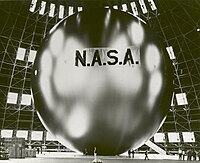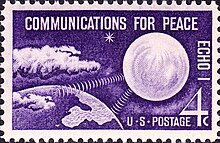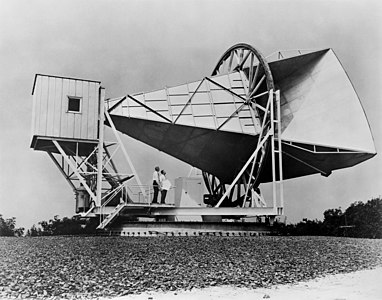Project Echo
 Echo 1 sits fully inflated at a Navy hangar in Weeksville, North Carolina | |
| Operator | NASA |
|---|---|
| Harvard designation | 1960 Alpha 11 |
| COSPAR ID | 1960-009A |
| SATCAT no. | 49 |
| Spacecraft properties | |
| Manufacturer | Bell Labs |
| Launch mass | 66 kg (146 lb) |
| Dimensions | 30.48 m (100.0 ft) diameter sphere when inflated |
| Start of mission | |
| Launch date | 03:39:43, August 12, 1960 (UTC) |
| Rocket | Thor-Delta |
| Launch site | Cape Canaveral AFS SLC-17A |
| End of mission | |
| Decay date | May 24, 1968 |
| Orbital parameters | |
| Reference system | Geocentric |
| Eccentricity | 0.01002 |
| Perigee altitude | 1,524 km (947 mi) |
| Apogee altitude | 1,684 km (1,046 mi) |
| Inclination | 47.2° |
| Period | 118.3 min |
 Echo 2 undergoing tensile stress test in a dirigible hangar at Weeksville, North Carolina | |
| Operator | NASA |
|---|---|
| COSPAR ID | 1964-004A |
| SATCAT no. | 740 |
| Spacecraft properties | |
| Manufacturer | Bell Labs |
| Dimensions | 41 m (135 ft) diameter sphere when inflated |
| Start of mission | |
| Launch date | 13:59:04, January 25, 1964 (UTC) |
| Rocket | Thor-Agena B |
| Launch site | Vandenberg AFB |
| End of mission | |
| Decay date | June 7, 1969 |
| Orbital parameters | |
| Reference system | Geocentric |
| Eccentricity | 0.01899 |
| Perigee altitude | 1,029 km (639 mi) |
| Apogee altitude | 1,316 km (818 mi) |
| Inclination | 81.5° |
| Period | 108.95 min |
Project Echo was the first passive communications satellite experiment. Each of the two American spacecraft, launched in 1960 and 1964, was a metalized balloon satellite acting as a passive reflector of microwave signals. Communication signals were bounced off them from one point on Earth to another.[1]

Echo 1
NASA's Echo 1 satellite was built by Gilmore Schjeldahl's G.T. Schjeldahl Company in Northfield, Minnesota. The balloon satellite would function as a reflector, not a transceiver; after it was placed in a low Earth orbit, a signal could be sent to it, reflected by its surface, and returned to Earth. [citation needed]
During ground inflation tests, 40,000 pounds (18,000 kg) of air were needed to fill the balloon, but while in orbit, several pounds of gas were all that was required to fill the sphere. At launch, the balloon weighed 156.995 pounds (71.212 kg), including 33.34 pounds (15.12 kg) of sublimating powders of two types.[2] According to NASA, "To keep the sphere inflated in spite of meteorite punctures and skin permeability, a make-up gas system using evaporating liquid or crystals of a subliming solid were [sic] incorporated inside the satellite."[3] One of the powders weighed 10 pounds (4.5 kg), with a very high vapor pressure; the other had a much lower vapor pressure.[2]
The first attempt to orbit an Echo satellite (also the maiden voyage of the Thor-Delta launch vehicle) miscarried when Echo 1 lifted off from Cape Canaveral's LC-17A on the morning of May 13, 1960. The Thor stage performed properly, but during the coasting phase, the attitude control jets on the unproven Delta stage failed to ignite, sending the payload into the Atlantic Ocean instead of into orbit.
Echo 1A (commonly referred to as Echo 1) was successfully put into a orbit of 944 to 1,048 miles (1,519 to 1,687 km) by another Thor-Delta,[4][5] and a microwave transmission from the Jet Propulsion Laboratory in Pasadena, California, was relayed by the satellite to Bell Laboratories in Holmdel, New Jersey, on August 12, 1960.[2]
The 30.5-meter (100 ft) diameter balloon was made of 0.5-mil-thick (12.7 μm) biaxially oriented PET film, metalized at a thickness of 0.2 micrometers (0.00787 mils) (a type of film commonly known by the trade name Mylar), and had a total mass of 180 kilograms (397 lb). It was used to redirect transcontinental and intercontinental telephone, radio, and television signals.[2] It also had 107.9 MHz telemetry beacons, powered by five nickel-cadmium batteries that were charged by 70 solar cells mounted on the balloon. The spacecraft aided the calculation of atmospheric density and solar pressure, due to its large area-to-mass ratio.[2] During the latter portion of its life, it was used to evaluate the technical feasibility of satellite triangulation.
As its shiny surface was also reflective in the range of visible light, Echo 1A was easily visible to the unaided eye over most of the Earth.
The spacecraft was nicknamed a "satelloon" by those involved in the project (a portmanteau combining satellite and balloon).
It was originally expected that Echo 1A would not survive long after its fourth dip into the atmosphere in July 1963, although estimates allowed the possibility that it would continue to orbit until 1964 or beyond.[2] It ended up surviving much longer than expected, and finally reentered Earth's atmosphere and burned up on May 24, 1968.
Echo 2
Echo 2 was a 41.1-meter-diameter (135 ft) balloon satellite, the last launched by Project Echo. A revised inflation system was used for the balloon, to improve its smoothness and sphericity. Echo 2's skin was rigidizable, unlike that of Echo 1A. Therefore, the balloon was capable of maintaining its shape without a constant internal pressure; a long-term supply of inflation gas was not needed, and it could easily survive strikes from micrometeoroids. The balloon was constructed from "a 0.35 mil (9 µm) thick mylar film sandwiched between two layers of 0.18 mil (4.5 µm) thick aluminum foil and bonded together."[6] It was inflated to a pressure that caused the metal layers of the laminate to slightly plastically deform, while the polymer was still in the elastic range. This resulted in a rigid and very smooth spherical shell.
Instrumentation included a beacon telemetry system that provided a tracking signal, monitored spacecraft skin temperature between −120 and +16 °C (−184 and 61 °F), and measured the internal pressure of the spacecraft between 0.00005 mm of mercury and 0.5 mm of mercury, especially during the initial inflation stages. The system consisted of two beacon assemblies powered by solar cell panels, and had a minimum power output of 45 mW at 136.02 MHz and 136.17 MHz.[7]
Echo 2 was launched January 25, 1964, on a Thor Agena rocket. In addition to passive communications experiments, it was used to investigate the dynamics of large spacecraft and for global geometric geodesy. Since it was larger than Echo 1A and orbiting in a near-polar orbit, Echo 2 was conspicuously visible to the unaided eye over all of the Earth. It reentered Earth's atmosphere and burned up on June 7, 1969.
Both Echo 1A and Echo 2 experienced a solar sail effect due to their large size and low mass.[8] Later passive communications satellites, such as OV1-08 PasComSat, solved the problems associated with this by using a grid-sphere design instead of a covered surface. Later yet, NASA abandoned passive communications systems altogether, in favor of active satellites.
Legacy
The Echo satellite program also provided the astronomical reference points required to accurately locate Moscow. This improved accuracy was sought by the U.S. military for the purpose of targeting intercontinental ballistic missiles.[9]
The large horn antenna at Holmdel constructed by Bell Labs for the Echo project was later used by Arno Penzias and Robert Woodrow Wilson for their Nobel Prize-winning discovery of the cosmic microwave background radiation.[10]
In popular culture
On December 15, 1960, the U.S. Post Office issued a postage stamp depicting Echo 1.

Gallery
-
Scale prototype of the Echo satellites undergoing a skin stress test on May 1, 1960.
-
Holmdel Horn Antenna, constructed for Project Echo, and later used to discover the cosmic microwave background radiation.
-
AT&T Bell Labs video about the first voice transmission via satellite and the engineers who conducted the effort.
See also
- AO-51, AMSAT-OSCAR 51 (also known as Phase 2E, or ECHO) – an amateur radio communications satellite launched in 2004.
- Courier 1B – world's first active repeater satellite, launched in 1960.
- List of communications satellite firsts
- PAGEOS – a similar balloon satellite project
- Project SCORE – world's first communications satellite, launched in 1958.
- Telstar – first active, direct relay communications satellite, launched in 1962.
- TransHab, a subsequent expandable spacecraft technology project pursued by NASA
- U.S. space exploration history on U.S. stamps
- Norman L. Crabill
References
- ^ "Echo 1, 1A, 2 Quicklook". Mission and Spacecraft Library. NASA. Archived from the original on May 27, 2010. Retrieved February 6, 2010.
- ^ a b c d e f Harrison M. Jones; I. I. Shapiro; P. E. Zadunaisky (1961). H. C. Van De Hulst, C. De Jager and A. F. Moore (ed.). "Solar Radiation Pressure Effects, Gas Leakage Rates, and Air Densities Inferred From the Orbit Of Echo I". Space Research II, Proceedings of the Second International Space Science Symposium, Florence, April 10–14, 1961. North-Holland Publishing Company-Amsterdam.
The observed variations of the Echo orbit - due primarily to the effects of the pressure of sunlight - are in excellent agreement with our theoretical results. The perigee altitude has an oscillation of large amplitude (approximately equal to 600 km) and long period (approximately equal to 300 days), which has a decisive influence on the lifetime of Echo I. Our present best estimate is that the balloon will perish in the summer of 1963.
- ^ NASA/Langley Research Center (NASA-LaRC) (June 29, 1965). "Static Inflation Test of 135 Ft Satellite In Weeksville, NC". Internet Archive. Retrieved March 15, 2020.
- ^ Astronautix.com, Echo Archived 2008-05-11 at the Wayback Machine
- ^ "Echo 1". NASA. Retrieved 8 October 2015.
- ^ Staugaitis, C. & Kobren, L. "Mechanical And Physical Properties of the Echo II Metal-Polymer Laminate (NASA TN D-3409)," NASA Goddard Space Flight Center (1966)
- ^ "Echo 2". NASA. Retrieved 2019-01-30.
- ^ Coulter, Dauna (31 July 2008). "A Brief History of Solar Sails". NASA. NASA. Archived from the original on 28 January 2010. Retrieved 4 February 2010.
- ^ Gray, Mike (1992). Angle of Attack: Harrison Storms and the Race to the Moon. W. W. Norton & Co. pp. 5–6. ISBN 0-393-01892-X.
- ^ "Arno Penzias - Biographical". nobelprize.org.
Further reading
- Elder, Donald C. (1995). Out from Behind the Eight-Ball: A History of Project Echo. AAS History Series. Vol. 16. Univelt for the American Astronomical Society. ISBN 0-87703-388-9.
- Nick D'Alto "The Inflatable Satellite", Invention and Technology Summer 2007, Volume 23, Number 1 pp. 38–43.
External links
- A film clip "Big Bounce, The" is available for viewing at the Internet Archive
- A film clip "Space Triumph. Discoverer Capsule Recovered From Orbit , 1960/08/15 (1960)" is available for viewing at the Internet Archive


